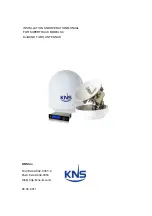
User’s Manual
1.
SATELLITE TECHNICAL CHARACTERISTICS
1.1
INTRODUCTION
This Section contains general information on the multi-region geostationary Hellas-Sat 2
satellite.
1.2
GENERAL CHARACTERISTICS
The Hellas- Sat 2 satellite is designed for a minimum operational lifetime of 15 years and its
orbital position can be controlled with ±0.09º East/West and ± 0.05º North/South accuracy
over at least 12 years. In order to enable the pointing of manually adjusted or program-tracked
antennas, HELLAS SAT provides, on request, the data for orbit determination to the Earth
Station operators. Up to thirty (30) transponders of 36 MHz bandwidth each are available for
simultaneous operation, in eclipse as well as in sunlight.
Reception and transmission take place via four dual polarized beam antennas. Two of them
(F1 & F2) are fixed, with a 2.5m main reflector each and dual offset Gregorian configuration of
single feed with numerically shaped main reflector to provide complex beam shape for efficient
illumination of Europe, and part of Middle East and N. Africa. The other two antennas (S1&S2)
also Gregorian, are steerable with a shaped parabolic reflector of 1.3m to provide spot
coverage and can be pointed anywhere over the surface of the visible Earth, currently pointing
M. East (S2) and S. Africa (S1).
1.3
FREQUENCY PLAN
The frequencies and polarization arrangement of the Hellas-Sat 2 satellite transponders are
shown in Figure 1.
The fixed coverage antenna F1 receives signals in the band 13.75-14.00 GHz whilst the fixed
coverage antenna F2 receives signals in the band 14.00-14.25 GHz. The steerable antenna S1
receives signals in the band of 13.75-14.00 GHz.
The steerable antenna S2 receives signals in the band 14.00-14.25 GHz on the horizontal
uplink polarization and in band 14.00-14.50 GHz on the vertical uplink polarization. There are
two types of receivers/downconverters.
Type 1 receiver provides frequency translation of either uplink band 13.75-14.00 GHz or 14.00-
14.25 GHz to downlink band 12.50-12.75 GHz using two switchable local oscillators
(1.244GHz and 1.5GHz respectively). These receivers are connected in a 8/6 redundancy
scheme.
Type 2 receiver provides frequency translation of uplink band 14.00 to 14.25GHz, to downlink
band 10.95 to 11.20 GHz using a 3.050 GHz local oscillator.These receivers are connected in
a 2/1 redundancy scheme.
There are also two downconverter assemblies that provide frequency translation of the S2
uplink band 14.25-14.50 GHz to downlink band 11.45 to 11.70 GHz using a 2.8 GHz local
oscillator and connected in a 2/1 redundancy scheme.
3
































